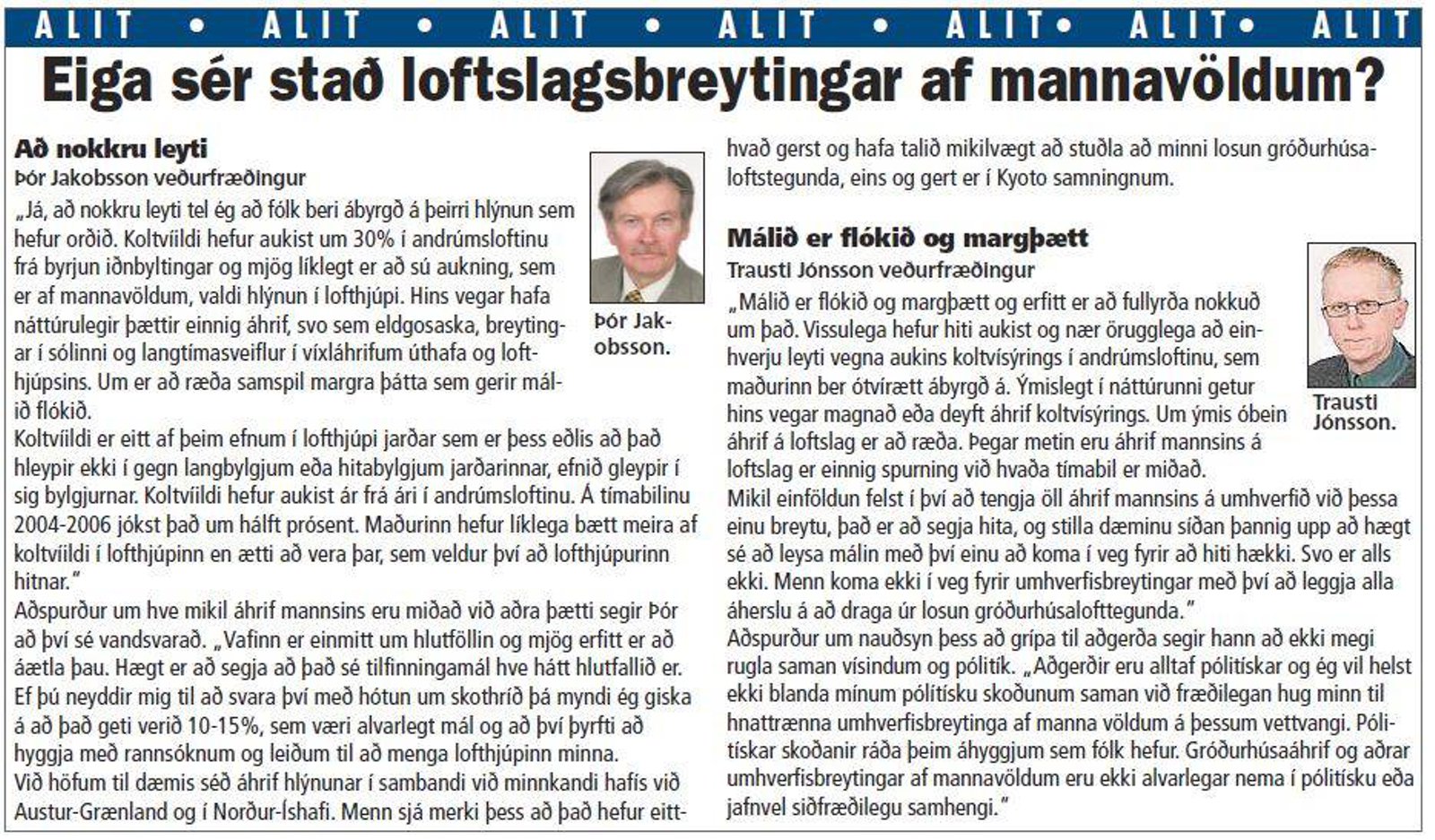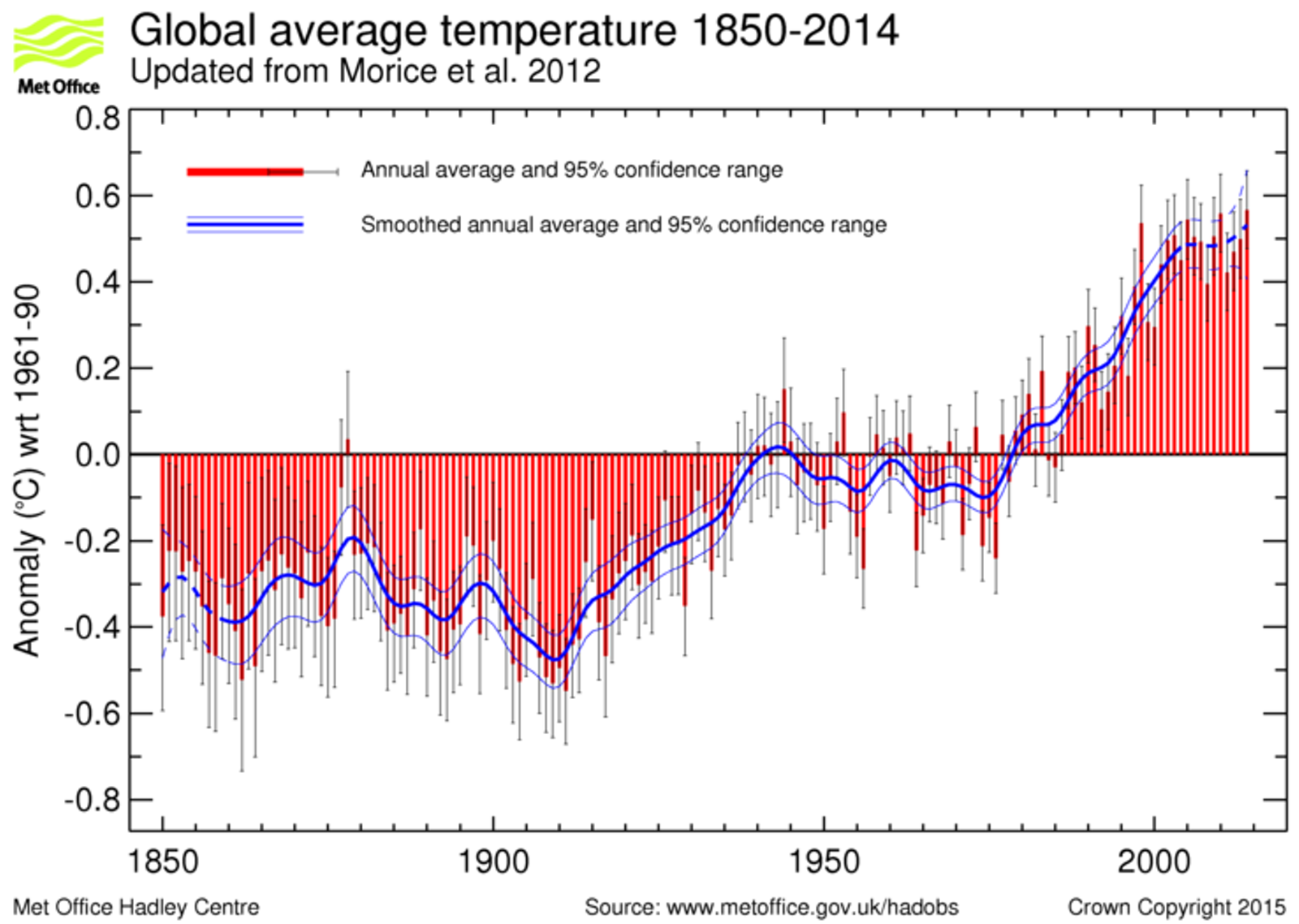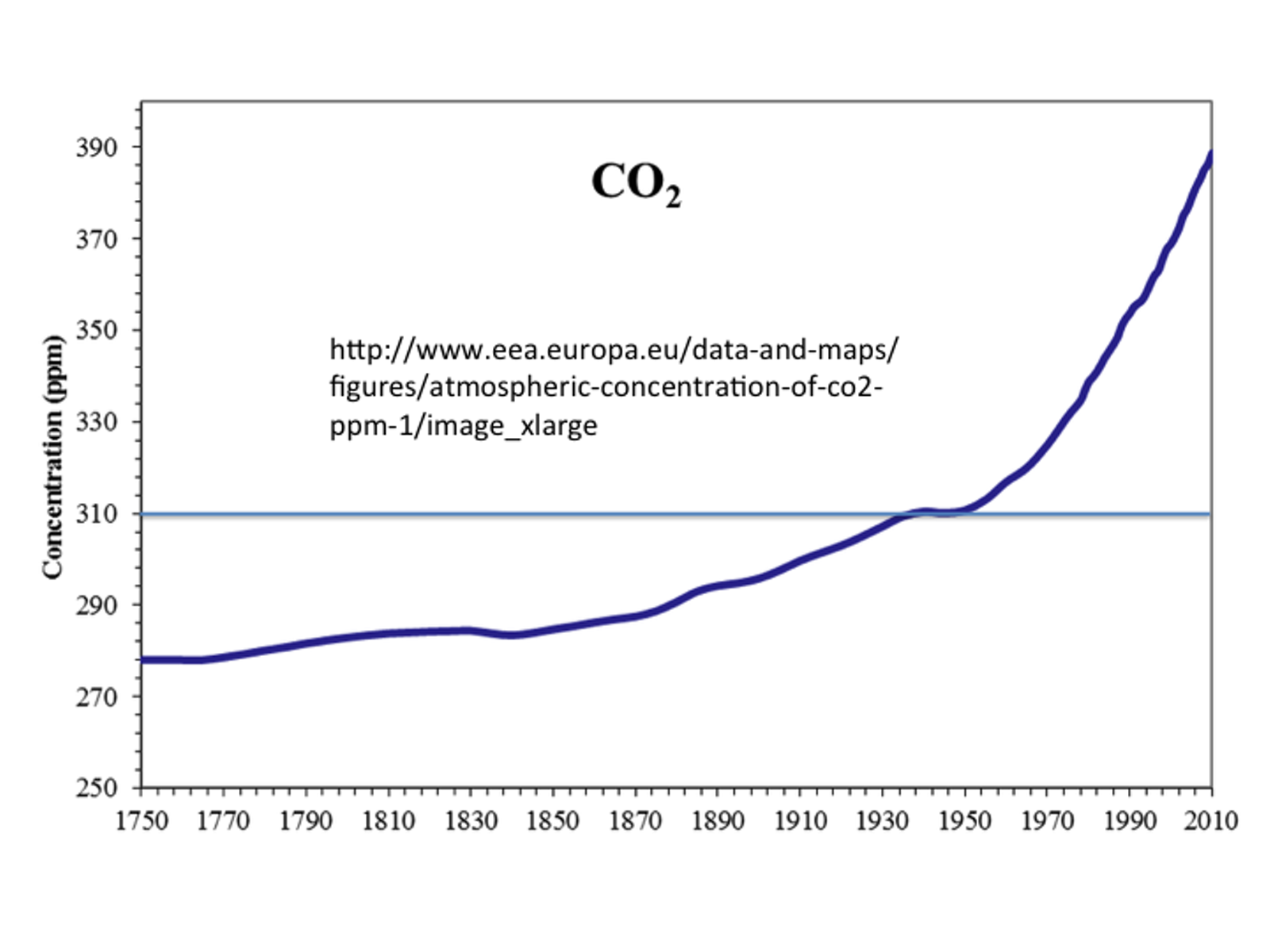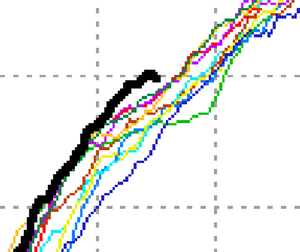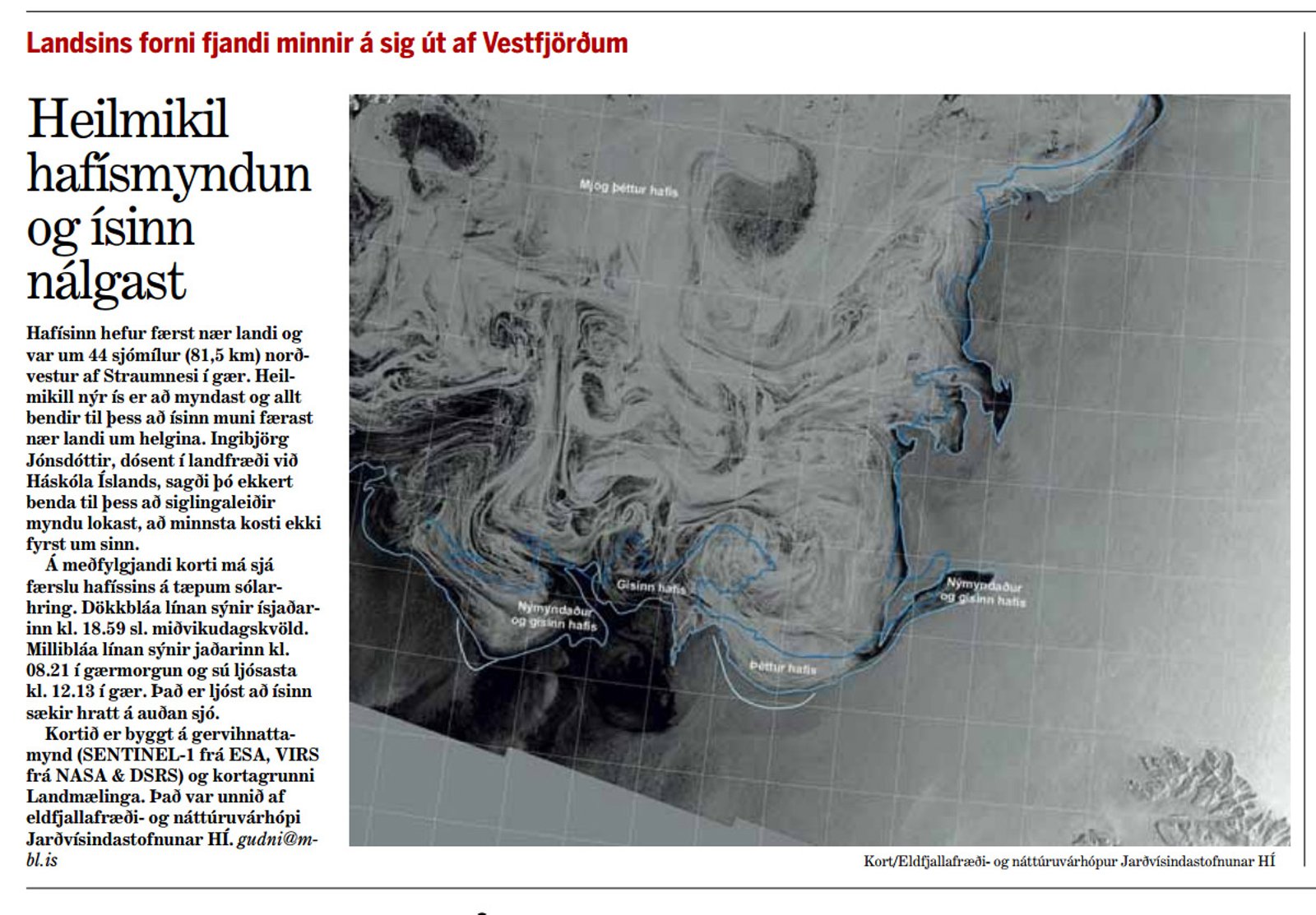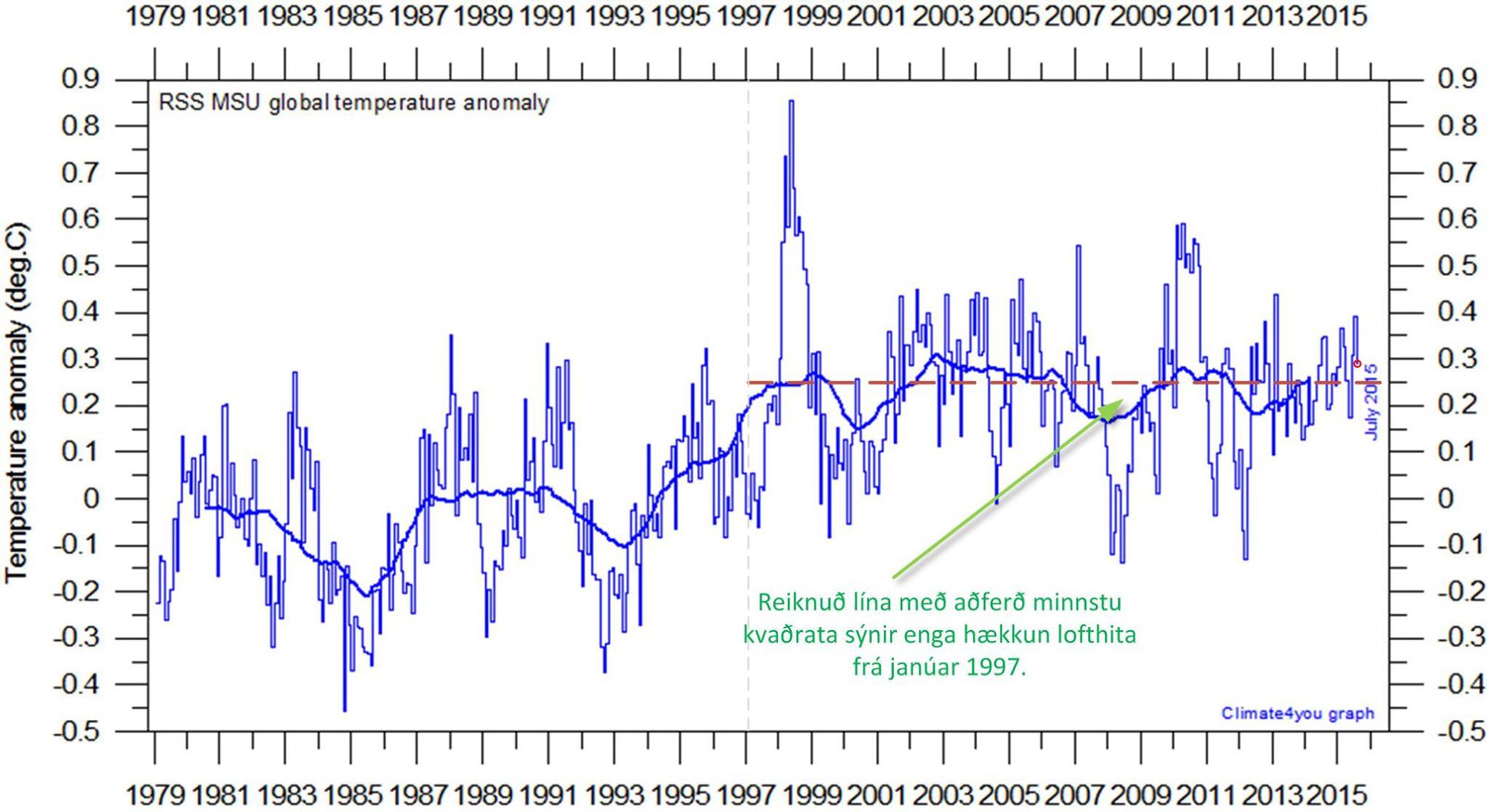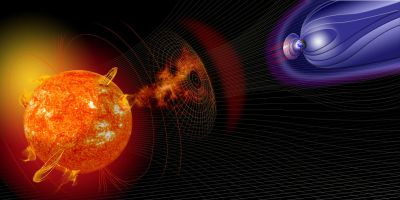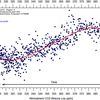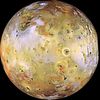Færsluflokkur: Vísindi og fræði
Fimmtudagur, 3. desember 2015
Eiga sér stað loftslagsbreytingar af mannavöldum...?
Úr Viðskiptablaðinu 13. desember 2006
Fyrir um áratug var stutt viðtal við þessa vísindamenn sem teljast verða vera meðal þeirra reyndustu á sviði veður- og loftslagsfræða hér á landi.
Þór: "Um er að ræða samspil margra þátta sem gerir málið flókið".
Trausti: "Málið er flókið og margþætt og erfitt að fullyrða niokkuð um það".
Páll Bergþórsson, okkar allra reyndasti og virtasti veðurfræðingur, er sama sinnis
og hefur birt áhugaverðar kenningar um áhrif hafíssins á svokallaða 60 ára sveiflu.
Allir eru þessir vísindamenn sammála um að það hafi hlýnað á undanförnum áratugum,
losun á koltvíildi hafi aukist verulega, en ekki sé hægt að kenna styrk
koltvíildis eingöngu um breytingar í hitafari, þó svo að áhrif þess séu einhver.
Úr Morgunblaðinu í dag 3. desember 2015
Eldri bloggpistlar sem fjalla um raunverulega "manngerða hlýnun":
Hvers vegna er NASA að afmynda hitaferilinn fyrir Reykjavík...?
Kann einhver skil á þessum undarlegheitum...?

NASA - GISS
Vísindi og fræði | Breytt s.d. kl. 15:28 | Slóð | Facebook
Sunnudagur, 29. nóvember 2015
Hvað er eðlilegt veðurfar...?
Er loftslag eðlilegt eins og það var fyrir 100 til 150 árum? Það felst í kenningunni um skaðlegar loftslagsbreytingar, þ.e. hlýnun frá þessu tímabili. Jörðin hefur hlýnað um 0,75 gráður. Í þessu felst einnig að loftslag hafi verið eðlilegt á þeim tíma meðan losun manna á koltvísýringi var enn óveruleg.
Samkvæmt mælingum er talið að hitastig jarðar hafi hækkað um því sem næst 0,75°C síðan um 1850. Kannski er það 0,8° afrúnnað, en það skiptir litlu máli því óvissumörkin eru samkvæmt ferlinum +/- 0,2°. Hvers vegna 1850? Jú það er vegna þess að sæmilega áreiðanlegar eldri mælingar á lofthita eru ekki til. Þá var Litlu ísöldinni ekki lokið. Verulegur hluti þessa tímabils, um það bil hálf öld, tilheyrir Litlu ísöldinni. Skekkir það ekki aðeins myndina? "Frá upphafi iðnbyltingar (um 1750) hefur hlýnað á jörðinni" má lesa á Vísindavefnum. Sé þessi tími notaður sem viðmið, þá tilheyra hvorki meira ná minna en 150 ár Litlu ísöldinni! Menn hafa af því miklar áhyggjur að meðalhiti jarðar hafi hækkað um því sem næst 0,8 gráður á 150 árum? Hver vill fullyrða að um 1850, á síðustu áratugum Litlu ísaldar, hafi veðurfar verið “rétt” og öll hækkun hita síðan þá sé “röng” og hættuleg? Það merkilega er að þetta er kjarninn í umræðunni um loftslagsmálin. (Aðeins er á reiki við hvaða tíma hitahækkunin er miðuð. Stundum 1860, stundum 1880 og stundum 1910. Í þessu sambandi skiptir það ekki máli, því allt eru þetta tímar sem tilheyra kuldatímabili Litlu ísaldar eins og greinilegt er ef myndin er skoðuð. Það eru einnig skiptar skoðanir um það hvenær Litlu ísöldinni lauk. Íslenskir jöklar gengu lengst fram á tímabilinu 1890-1920, sjá hér. Sumir miða við 1850, en aðrir ekki fyrr en 1920). Við sjáum greinilega á hitaferlinum frá Bresku Veðurstofunni að Litlu Ísöldinni lýkur ekki fyrr en um 1920, þá verður mjög hröð hlýnun fram að 1945, síðan kyrrstaða til um 1975 er hitinn fer að rísa hratt til ársins 2000, og að lokum kyrrstaða til dagsins í dag. Eftirtektarvert er að á tímabilinu 1920 til 1945 er álíka hröð og álíka mikil hækkun á hitastigi og á tímabilinu 1975 til 2000. Hvort tveggja 25 ára tímabil. Það er umhugsunarvert að losun manna á koltvísýringi var tiltölulega lítil fyrr en eftir miðja síðustu öld er losunin fór hratt vaxandi. Sjá línuritið með CO2 hér fyrir neðan. Það flækir auðvitað málið dálítið. Var það kannski náttúran sem var að verki á fyrra tímabilinu og mannfólkið á hinu síðara? Eða á náttúran einhvern þátt í hitabreytingunum yfir allt tímabilið?
Við tökum eftir því á myndinni frá Bresku veðurstofunni (Met Office) hér fyrir ofan að meðalhitinn yfir allt tímabilið er nokkurn vegin sá sami og mældist í kyrrstöðunni 1945-1975. Reyndar er lárétta línan við 0,0°C örlítið ofar. Væri ekki eðlilegra að miða hækkun lofthitans við það tímabil frekar en Litlu Ísöldina eins og gert er? Þá væri hækkunin sem við værum með áhyggjur af um það bil 0,5° í stað 0,8°. Það munar um minna. Svo er ekki útilokað að einhver hluti þessara 0,5 gráða séu eðlilegar sveiflur í náttúrunni.
Í fyrirsögn þessa pistils stendur: Hvað er eðlilegt veðurfar? Er það eins og það er í dag, eins og um miðja síðustu öld, eða eins og á tímum Charles Dickens? Svo virðist sem margir (flestir?) vilji að hnattrænt loftslag verði aftur eins og það var á síðustu áratugum Litlu ísaldar, þ.e. á þeim árum sem fjöldi Íslendinga hélt til vesturheims í leit að betra lífi, en það er önnur saga...
|

|
„Það er ekkert plan B“ |
| Tilkynna um óviðeigandi tengingu við frétt | |
Vísindi og fræði | Breytt 1.12.2015 kl. 08:45 | Slóð | Facebook
Miðvikudagur, 25. nóvember 2015
Ólafur Jóhann Ólafsson: Betra efni í forseta get ég ekki hugsað mér...
Einn er sá maður sem gæti verið mikill fengur að fá sem forseta Íslands. Hann lauk prófi með láði sem eðlisfræðingur frá Brandeis University í útjaðri Boston í Bandaríkjunum 1985. Hann hóf störf hjá Sony í Bandaríkjunum strax að loknu námi. Tíu árum síðar var hann kjörinn aðstoðarforstjóri fyrirtækisins og forstjóri margmiðlunardeildar þess. Árið 1996 hóf hann störf hjá fjárfestingarfyrirtækinu Advanta og var síðan ráðinn annar tveggja yfirmanna Time Warner Digital Media 1999. Ólafur Jóhann var mikill námsmaður og miklum metum hjá prófessorum Brandeis háskólans, enda komst hann strax að námi loknu til metorða hjá stórfyrirtækjum. Ólafur er eins og flestir vita einnig þekktur rithöfundur og með einstaklega góða framkomu. Hann er jafnvígur á raunvísindi og hugvísindi. Betra efni í forseta get ég varla hugsað mér.
Myndin af Ólafi Jóhanni var fengin að láni með bessaleyfi af vef Forlagsins. Ég vona mér fyrirgefist að hafa ekki beðið um leyfi. Textinn ber þess væntanlega merki að hafa að hluta verið fenginn að láni á sömu kjörum af vefjum Borgarbókasafnsins og Forlagsins.
|
Föstudagur, 20. nóvember 2015
"Heilmikil hafísmyndun og ísinn nálgast..."
Það er auðvitað sjálfsagt að fylgjast með landsins forna fjarna.
Enn sem komið er heldur hann sig fjarri, en hver veit hvernig staðan verður á næstu árum...?
Myndirnar eru frá Dönsku veðurstofunni DMI.
http://ocean.dmi.dk/arctic/old_icecover.uk.php
Klippt úr efstu myndinni
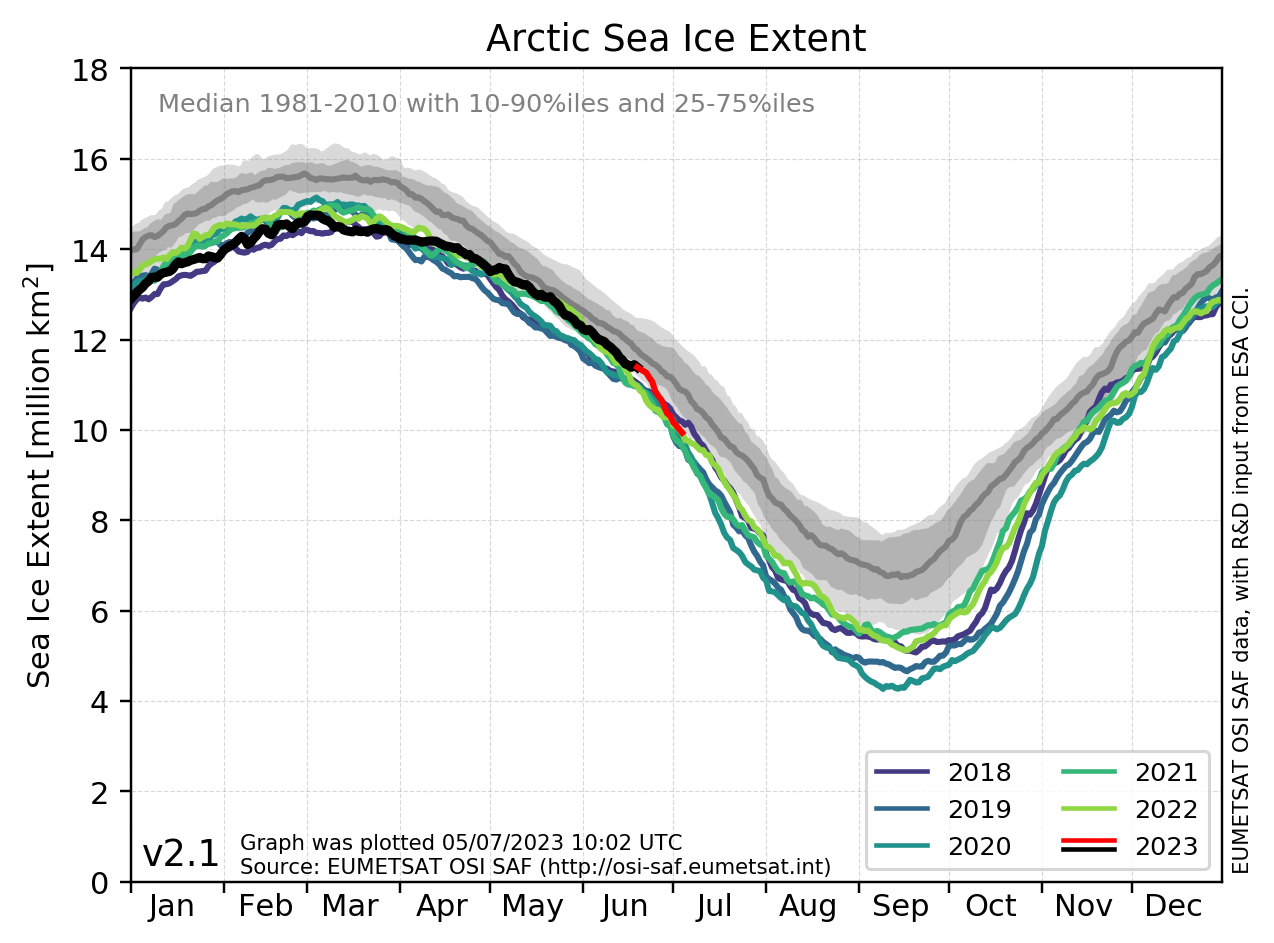
http://ocean.dmi.dk/arctic/icecover.uk.php
Uppfært 25. nóvember: Í dag birtist loksins nýr ferill á vef DMI eftir 12 daga hlé. Hann er dagsettur 24/11/15. Ferillinn sem var orðinn vikugamall þegar pistillinn var skrifaður 20. nóvember hefur því verið uppfærður.
Sjá nýjustu útgáfu beggja ferlanna með því að smella á krækjurnar undir þeim.
Uppfært 22. nóvember: Myndin hér að ofan hefur verið óbreytt hjá DMI síðan 13/11/15, sem bendir til einhverrar bilunar.
Frétt Morgunblaðsins 20. nóvember 2015

|
Hafísinn nálgast |
| Tilkynna um óviðeigandi tengingu við frétt | |
Vísindi og fræði | Breytt 25.11.2015 kl. 15:19 | Slóð | Facebook
Föstudagur, 6. nóvember 2015
Jørgen Peder Steffensen hjá Niels Bohr Institute: Hlýrra á Grænlandi fyrir árþúsundi en í dag og ómögulegt að dæma um hvort hlýindin nú séu náttúruleg eða af mannavöldum...
Jørgen Peder Steffensen jarðeðlisfræðingur og lektor hjá Niels Bohr Institutet, Københavns Universitet fjallar í þessu stutta en fróðlega myndbandi um rannsóknir á borkjörnum frá Grænlandsjökli. Dr. Jørgen Peder Steffensen hefur meðal annars starfað mikið með íslenska eðlis- og jöklafræðingnum Dr. Sigfúsi Johnsen. Hann fræðir okkur meðal annars á því að fyrir árþúsundi hafi hitinn á Grænlandi verið 1,5 gráðum hærri en í dag, og að mjög erfitt sé að sýna fram á hvort núverndi hlýindi stafi af mannavöldum eða eigi sér náttúrulegar orsakir.
- Fyrir árþúsundi var hitinn á Grænlandi 1,5 gráðum hærri en í dag. - Hann var ef til vill 2.5 C hærri fyrir 4000 árum. - Rannsóknir víðar í heiminum styðja þessa mynd. - Mjög erfitt að sýna fram á hvort núverndi hlýindi stafi af mannavöldum eða eigi sér náttúrulegar orsakir
|

Vísindi og fræði | Breytt s.d. kl. 12:30 | Slóð | Facebook
Þriðjudagur, 20. október 2015
Hafísinn minnir á sig. Meiri en síðustu ár...
Á myndinni má sjá útbreiðslu hafíss á norðurslóðum í dag 20. október. Eins og sjá má á svarta ferlinum mælist útbreiðslan meiri en flest síðastliðin 10 ár. Neðri myndin er stækkuð úrklippa úr þeirri efri. Ferillinn er frá Hafísdeild Dönsku Veðurstofunnar DMI, en þar birtist daglega nýr ferill. Það er greinilegt eins og staðan er í dag, að hafísinn er ekkert að hverfa. Ferillinn gefur þó ekki neina vísbendingu um þróun næstu daga, mánuði eða ár, en fróðlegt verður að fylgjast með hvað er á seyði með því að smella hér og hér.
Þykkt hafíssins skiptir líka máli. Á næstu mynd sést að nú (rauði ferillinn) er þykktin meiri en 2004, 2009, 2010, 2011 og 2013.
Sjálfsagt kjósa flestir að hafísinn verði sem minnstur og alls ekki að hann gerist nærgöngull við okkur eins og síðast gerðist á hafísárunum um 1970. En er það nú alveg víst að við getum stólað á að siglingar um norðuríshafið verði raunhæfar og að umskipunarhöfn í Finnafirði verði að veruleika? Er alveg víst að landsins forni fjandi heimsæki okkur ekki einhvern tíman á næstu árum? Spyr sá sem ekki veit... |
Vísindi og fræði | Breytt 21.10.2015 kl. 11:38 | Slóð | Facebook
Mánudagur, 19. október 2015
Mögnuð ræða Dr. Patrick Moore stofnanda Greenpeace...
Dr. Patrick Moore umhverfisfræðingur, stofnandi Greenpeace, hélt í síðustu viku magnaðan fyrirlestur. Myndband er hér fyrir neðan, en prentaða útgáfu má lesa neðar á síðunni eða með því að smella hér. Patrick Moore ræðir hér uppvaxtarár sín og skólagöngu og þá tíma sem hann starfaði með Greenpeace eftir að hann tók þátt í stofnun samtakanna, svo og hvers vegna hann yfirgaf samtökin. Síðan fjallar hann um koltvísýring jarðsögunni og bendir á ýmsar jákvæðar hliðar málsins, en koltvísýringur er undirstaða alls lífs á jörðinni. Þetta er einkar fróðlegt og vel þess virði að hlusta. Óneitanlega umhugsunarverður vinkill á málið.
(Sjá annað myndband neðst á síðunni). |
Hér er gömul vefsíða frá Greenpeace. The Founders of GreenpeacePatrick Moore er annar frá vinstri í efri röð á myndinni á þessari gömlu Greenpeace vefsíðu, sem er afrituð hér fyrir neðan.
|
Kjósi einhver að lesa frekar en að horfa, þá er fyrirlesturinn eða ræðan frá 14. október 2015 hér í heild sinni:
My Lords and Ladies, Ladies and Gentlemen. Thank you for the opportunity to set out my views on climate change. As I have stated publicly on many occasions, there is no definitive scientific proof, through real-world observation, that carbon dioxide is responsible for any of the slight warming of the global climate that has occurred during the past 300 years, since the peak of the Little Ice Age. If there were such a proof through testing and replication it would have been written down for all to see. The contention that human emissions are now the dominant influence on climate is simply a hypothesis, rather than a universally accepted scientific theory. It is therefore correct, indeed verging on compulsory in the scientific tradition, to be skeptical of those who express certainty that “the science is settled” and “the debate is over”. But there is certainty beyond any doubt that CO2 is the building block for all life on Earth and that without its presence in the global atmosphere at a sufficient concentration this would be a dead planet. Yet today our children and our publics are taught that CO2 is a toxic pollutant that will destroy life and bring civilization to its knees. Tonight I hope to turn this dangerous human-caused propaganda on its head. Tonight I will demonstrate that human emissions of CO2 have already saved life on our planet from a very untimely end. That in the absence of our emitting some of the carbon back into the atmosphere from whence it came in the first place, most or perhaps all life on Earth would begin to die less than two million years from today.
But first a bit of background. I was born and raised in the tiny floating village of Winter Harbour on the northwest tip of Vancouver Island, in the rainforest by the Pacific. There was no road to my village so for eight years myself and a few other children were taken by boat each day to a one-room schoolhouse in the nearby fishing village. I didn’t realize how lucky I was playing on the tide flats by the salmon-spawning streams in the rainforest, until I was sent off to boarding school in Vancouver where I excelled in science. I did my undergraduate studies at the University of British Columbia, gravitating to the life sciences – biology, biochemistry, genetics, and forestry – the environment and the industry my family has been in for more than 100 years. Then, before the word was known to the general public, I discovered the science of ecology, the science of how all living things are inter-related, and how we are related to them. At the height of the Cold War, the Vietnam War, the threat of all-out nuclear war and the newly emerging consciousness of the environment I was transformed into a radical environmental activist. While doing my PhD in ecology in 1971 I joined a group of activists who had begun to meet in the basement of the Unitarian Church, to plan a protest voyage against US hydrogen bomb testing in Alaska. We proved that a somewhat rag-tag looking group of activists could sail an old fishing boat across the north Pacific ocean and help change the course of history. We created a focal point for the media to report on public opposition to the tests. When that H-bomb exploded in November 1971, it was the last hydrogen bomb the United States ever detonated. Even though there were four more tests planned in the series, President Nixon canceled them due to the public opposition we had helped to create. That was the birth of Greenpeace. Flushed with victory, on our way home from Alaska we were made brothers of the Namgis Nation in their Big House at Alert Bay near my northern Vancouver Island home. For Greenpeace this began the tradition of the Warriors of the Rainbow, after a Cree Indian legend that predicted the coming together of all races and creeds to save the Earth from destruction. We named our ship the Rainbow Warrior and I spent the next fifteen years in the top committee of Greenpeace, on the front lines of the environmental movement as we evolved from that church basement into the world’s largest environmental activist organization. Next we took on French atmospheric nuclear testing in the South Pacific. They proved a bit more difficult than the US nuclear tests. It took years to eventually drive these tests underground at Mururoa Atoll in French Polynesia. In 1985, under direct orders from President Mitterrand, French commandos bombed and sank the Rainbow Warrior in Auckland Harbour, killing our photographer. Those protests continued until long after I left Greenpeace. It wasn’t until the mid-1990s that nuclear testing finally ended in the South Pacific, and it most other parts of the world as well. Going back to 1975, Greenpeace set out to save the whales from extinction at the hands of huge factory whaling fleets. We confronted the Soviet factory whaling fleet in the North Pacific, putting ourselves in front of their harpoons in our little rubber boats to protect the fleeing whales. This was broadcast on television news around the world, bringing the Save the Whales movement into everyone’s living rooms for the first time. After four years of voyages, in 1979 factory whaling was finally banned in the North Pacific, and by 1981 in all the world’s oceans. In 1978 I sat on a baby seal off the East Coast of Canada to protect it from the hunter’s club. I was arrested and hauled off to jail, the seal was clubbed and skinned, but a photo of me being arrested while sitting on the baby seal appeared in more than 3000 newspapers around the world the next morning. We won the hearts and minds of millions of people who saw the baby seal slaughter as outdated, cruel, and unnecessary. Why then did I leave Greenpeace after 15 years in the leadership? When Greenpeace began we had a strong humanitarian orientation, to save civilization from destruction by all-out nuclear war. Over the years the “peace” in Greenpeace was gradually lost and my organization, along with much of the environmental movement, drifted into a belief that humans are the enemies of the earth. I believe in a humanitarian environmentalism because we are part of nature, not separate from it. The first principle of ecology is that we are all part of the same ecosystem, as Barbara Ward put it, “One human family on spaceship Earth”, and to preach otherwise teaches that the world would be better off without us. As we shall see later in the presentation there is very good reason to see humans as essential to the survival of life on this planet. In the mid 1980s I found myself the only director of Greenpeace International with a formal education in science. My fellow directors proposed a campaign to “ban chlorine worldwide”, naming it “The Devil’s Element”. I pointed out that chlorine is one of the elements in the Periodic Table, one of the building blocks of the Universe and the 11th most common element in the Earth’s crust. I argued the fact that chlorine is the most important element for public health and medicine. Adding chlorine to drinking water was the biggest advance in the history of public health and the majority of our synthetic medicines are based on chlorine chemistry. This fell on deaf ears, and for me this was the final straw. I had to leave. When I left Greenpeace I vowed to develop an environmental policy that was based on science and logic rather than sensationalism, misinformation, anti-humanism and fear. In a classic example, a recent protest led by Greenpeace in the Philippines used the skull and crossbones to associate Golden Rice with death, when in fact Golden Rice has the potential to help save 2 million children from death due to vitamin A deficiency every year.
The Keeling curve of CO2 concentration in the Earth’s atmosphere since 1959 is the supposed smoking gun of catastrophic climate change. We presume CO2 was at 280 ppm at the beginning of the Industrial Revolution, before human activity could have caused a significant impact. I accept that most of the rise from 280 to 400 ppm is caused by human CO2 emissions with the possibility that some of it is due to outgassing from warming of the oceans. NASA tells us that “Carbon Dioxide Controls Earth’s Temperature” in child-like denial of the many other factors involved in climate change. This is reminiscent of NASA’s contention that there might be life on Mars. Decades after it was demonstrated that there was no life on Mars, NASA continues to use it as a hook to raise public funding for more expeditions to the Red Planet. The promulgation of fear of Climate Change now serves the same purpose. As Bob Dylan prophetically pointed out, “Money doesn’t talk, it swears”, even in one of the most admired science organizations in the world. On the political front the leaders of the G7 plan to “end extreme poverty and hunger” by phasing out 85% of the world’s energy supply including 98% of the energy used to transport people and goods, including food. The Emperors of the world appear clothed in the photo taken at the close of the meeting but it was obviously Photo-shopped. They should be required to stand naked for making such a foolish statement. The world’s top climate body, the Intergovernmental Panel on Climate change, is hopelessly conflicted by its makeup and it mandate. The Panel is composed solely of the World Meteorological Organization, weather forecasters, and the United Nations Environment Program, environmentalists. Both these organizations are focused primarily on short-term timescales, days to maybe a century or two. But the most significant conflict is with the Panel’s mandate from the United Nations. They are required only to focus on “a change of climate which is attributed directly or indirectly to human activity that alters the composition of the atmosphere, and which is in addition to natural climate variability.”
So if the IPCC found that climate change was not being affected by human alteration of the atmosphere or that it is not “dangerous” there would be no need for them to exist. They are virtually mandated to find on the side of apocalypse. Scientific certainty, political pandering, a hopelessly conflicted IPCC, and now the Pope, spiritual leader of the Catholic Church, in a bold move to reinforce the concept of original sin, says the Earth looks like “an immense pile of filth” and we must go back to pre-industrial bliss, or is that squalor? And then there is the actual immense pile of filth fed to us more than three times daily by the green-media nexus, a seething cauldron of imminent doom, like we are already condemned to Damnation in Hell and there is little chance of Redemption. I fear for the end of the Enlightenment. I fear an intellectual Gulag with Greenpeace as my prison guards.
Let’s begin with our knowledge of the long-term history of the Earth’s temperature and of CO2 in the Earth’s atmosphere. Our best inference from various proxies back indicate that CO2 was higher for the first 4 billion years of Earth’s history than it has been since the Cambrian Period until today. I will focus on the past 540 million years since modern life forms evolved. It is glaringly obvious that temperature and CO2 are in an inverse correlation at least as often as they are in any semblance of correlation. Two clear examples of reverse correlation occurred 150 million years and 50 million years ago. At the end of the Jurassic temperature fell dramatically while CO2 spiked. During the Eocene Thermal Maximum, temperature was likely higher than any time in the past 550 million years while CO2 had been on a downward track for 100 million years. This evidence alone sufficient to warrant deep speculation of any claimed lock-step causal relationship between CO2 and temperature. The Devonian Period beginning 400 million years ago marked the culmination of the invasion of life onto the land. Plants evolved to produce lignin, which in combination with cellulose, created wood which in turn for the first time allowed plants to grow tall, in competition with each other for sunlight. As vast forests spread across the land living biomass increased by orders of magnitude, pulling down carbon as CO2 from the atmosphere to make wood. Lignin is very difficult to break down and no decomposer species possessed the enzymes to digest it. Trees died atop one another until they were 100 metres or more in depth. This was the making of the great coal beds around the world as this huge store of sequestered carbon continued to build for 90 million years. Then, fortunately for the future of life, white rot fungi evolved to produce the enzymes that can digest lignin and coincident with that the coal-making era came to an end. There was no guarantee that fungi or any other decomposer species would develop the complex of enzymes required to digest lignin. If they had not, CO2, which had already been drawn down for the first time in Earth’s history to levels similar to todays, would have continued to decline as trees continued to grow and die. That is until CO2 approached the threshold of 150 ppm below which plants begin first to starve, then stop growing altogether, and then die. Not just woody plants but all plants. This would bring about the extinction of most, if not all, terrestrial species, as animals, insects, and other invertebrates starved for lack of food. And that would be that. The human species would never have existed. This was only the first time that there was a distinct possibility that life would come close to extinguishing itself, due to a shortage of CO2, which is essential for life on Earth. A well-documented record of global temperature over the past 65 million years shows that we have been in a major cooling period since the Eocene Thermal Maximum 50 million years ago. The Earth was an average 16C warmer then, with most of the increased warmth at the higher latitudes. The entire planet, including the Arctic and Antarctica were ice-free and the land there was covered in forest. The ancestors of every species on Earth today survived through what may have been the warmest time in the history of life. It makes one wonder about dire predictions that even a 2C rise in temperature from pre-industrial times would cause mass extinctions and the destruction of civilization. Glaciers began to form in Antarctica 30 million years ago and in the northern hemisphere 3 million years ago. Today, even in this interglacial period of the Pleistocene Ice Age, we are experiencing one of the coldest climates in the Earth’s history. Coming closer to the present we have learned from Antarctic ice cores that for the past 800,000 years there have been regular periods of major glaciation followed by interglacial periods in 100,000 year-cycles. These cycles coincide with the Milankovitch cycles that are tied to the eccentricity of the Earth’s orbit and its axial tilt. It is highly plausible that these cycles are related to solar intensity and the seasonal distribution of solar heat on the Earth’s surface. There is a strong correlation between temperature and the level of atmospheric CO2 during these successive glaciations, indicating a possible cause-effect relationship between the two. CO2 lags temperature by an average of 800 years during the most recent 400,000-year period, indicating that temperature is the cause, as the cause never comes after the effect. Looking at the past 50,000 years of temperature and CO2 we can see that changes in CO2 follow changes in temperature. This is as one could expect, as the Milankovitch cycles are far more likely to cause a change in temperature than a change in CO2. And a change in the temperature is far more likely to cause a change in CO2 due to outgassing of CO2 from the oceans during warmer times and an ingassing (absorption) of CO2 during colder periods. Yet climate alarmists persist in insisting that CO2 is causing the change in temperature, despite the illogical nature of that assertion.
It is sobering to consider the magnitude of climate change during the past 20,000 years, since the peak of the last major glaciation. At that time there were 3.3 kilometres of ice on top of what is today the city of Montreal, a city of more than 3 million people. 95% of Canada was covered in a sheet of ice. Even as far south as Chicago there was nearly a kilometre of ice. If the Milankovitch cycle continues to prevail, and there is little reason aside from our CO2 emissions to think otherwise, this will happen gradually again during the next 80,000 years. Will our CO2 emissions stave off another glaciation as James Lovelock has suggested? There doesn’t seem to be much hope of that so far, as despite 1/3 of all our CO2 emissions being released during the past 18 years the UK Met Office contends there has been no statistically significant warming during this century. At the height of the last glaciation the sea level was about 120 metres lower than it is today. By 7,000 years ago all the low-altitude, mid-latitude glaciers had melted. There is no consensus about the variation in sea level since then although many scientists have concluded that the sea level was higher than today during the Holocene Thermal optimum from 9,000 to 5,000 years ago when the Sahara was green. The sea level may also have been higher than today during the Medieval Warm Period. Hundred of islands near the Equator in Papua, Indonesia, have been undercut by the sea in a manner that gives credence to the hypothesis that there has been little net change in sea level in the past thousands of years. It takes a long time for so much erosion to occur from gentle wave action in a tropical sea. Coming back to the relationship between temperature and CO2 in the modern era we can see that temperature has risen at a steady slow rate in Central England since 1700 while human CO2 emissions were not relevant until 1850 and then began an exponential rise after 1950. This is not indicative of a direct causal relationship between the two. After freezing over regularly during the Little Ice Age the River Thames froze for the last time in 1814, as the Earth moved into what might be called the Modern Warm Period.
The IPCC states it is “extremely likely” that human emissions have been the dominant cause of global warming “since the mid-20th century”, that is since 1950. They claim that “extremely” means 95% certain, even though the number 95 was simply plucked from the air like an act of magic. And “likely” is not a scientific word but rather indicative of a judgment, another word for an opinion. There was a 30-year period of warming from 1910-1940, then a cooling from 1940 to 1970, just as CO2 emissions began to rise exponentially, and then a 30-year warming from 1970-2000 that was very similar in duration and temperature rise to the rise from 1910-1940. One may then ask “what caused the increase in temperature from 1910-1940 if it was not human emissions? And if it was natural factors how do we know that the same natural factors were not responsible for the rise between 1970-2000.” You don’t need to go back millions of years to find the logical fallacy in the IPCC’s certainty that we are the villains in the piece. Water is by far the most important greenhouse gas, and is the only molecule that is present in the atmosphere in all three states, gas, liquid, and solid. As a gas, water vapour is a greenhouse gas, but as a liquid and solid it is not. As a liquid water forms clouds, which send solar radiation back into space during the day and hold heat in at night. There is no possibility that computer models can predict the net effect of atmospheric water in a higher CO2 atmosphere. Yet warmists postulate that higher CO2 will result in positive feedback from water, thus magnifying the effect of CO2 alone by 2-3 times. Other scientists believe that water may have a neutral or negative feedback on CO2. The observational evidence from the early years of this century tends to reinforce the latter hypothesis.
How many politicians or members of the media or the public are aware of this statement about climate change from the IPCC in 2007? “we should recognise that we are dealing with a coupled nonlinear chaotic system, and therefore that the long-term prediction of future climate states is not possible.” There is a graph showing that the climate models have grossly exaggerated the rate of warming that confirms the IPCC statement. The only trends the computer models seem able to predict accurately are ones that have already occurred.
Coming to the core of my presentation, CO2 is the currency of life and the most important building block for all life on Earth. All life is carbon-based, including our own. Surely the carbon cycle and its central role in the creation of life should be taught to our children rather than the demonization of CO2, that “carbon” is a “pollutant” that threatens the continuation of life. We know for a fact that CO2 is essential for life and that it must be at a certain level in the atmosphere for the survival of plants, which are the primary food for all the other species alive today. Should we not encourage our citizens, students, teachers, politicians, scientists, and other leaders to celebrate CO2 as the giver of life that it is? It is a proven fact that plants, including trees and all our food crops, are capable of growing much faster at higher levels of CO2 than present in the atmosphere today. Even at the today’s concentration of 400 ppm plants are relatively starved for nutrition. The optimum level of CO2 for plant growth is about 5 times higher, 2000 ppm, yet the alarmists warn it is already too high. They must be challenged every day by every person who knows the truth in this matter. CO2 is the giver of life and we should celebrate CO2 rather than denigrate it as is the fashion today. We are witnessing the “Greening of the Earth” as higher levels of CO2, due to human emissions from the use of fossil fuels, promote increased growth of plants around the world. This has been confirmed by scientists with CSIRO in Australia, in Germany, and in North America. Only half of the CO2 we are emitting from the use of fossil fuels is showing up in the atmosphere. The balance is going somewhere else and the best science says most of it is going into an increase in global plant biomass. And what could be wrong with that, as forests and agricultural crops become more productive? All the CO2 in the atmosphere has been created by outgassing from the Earth’s core during massive volcanic eruptions. This was much more prevalent in the early history of the Earth when the core was hotter than it is today. During the past 150 million years there has not been enough addition of CO2 to the atmosphere to offset the gradual losses due to burial in sediments.
Let’s look at where all the carbon is in the world, and how it is moving around. Today, at just over 400 ppm CO2 there are 850 billion tons of CO2 in the atmosphere. By comparison, when modern life-forms evolved over 500 million years ago there was nearly 15,000 billion tons of CO2 in the atmosphere, 17 times today’s level. Plants and soils combined contain more than 2,000 billion tons of carbon, more that twice as much as the entire global atmosphere. The oceans contain 38,000 billion tons of dissolved CO2, 45 times as much as in the atmosphere. Fossil fuels, which were made from plants that pulled CO2 from the atmosphere account for 5,000 – 10,000 billion tons of carbon, 6 – 12 times as much carbon as is in the atmosphere. But the truly stunning number is the amount of carbon that has been sequestered from the atmosphere and turned into carbonaceous rocks. 100,000,000 billion tons, that’s one quadrillion tons of carbon, have been turned into stone by marine species that learned to make armour-plating for themselves by combining calcium and carbon into calcium carbonate. Limestone, chalk, and marble are all of life origin and amount to 99.9% of all the carbon ever present in the global atmosphere. The white cliffs of Dover are made of the calcium carbonate skeletons of coccolithophores, tiny marine phytoplankton. The vast majority of the carbon dioxide that originated in the atmosphere has been sequestered and stored quite permanently in carbonaceous rocks where it cannot be used as food by plants. Beginning 540 million years ago at the beginning of the Cambrian Period many marine species of invertebrates evolved the ability to control calcification and to build armour plating to protect their soft bodies. Shellfish such as clams and snails, corals, coccolithofores (phytoplankton) and foraminifera (zooplankton) began to combine carbon dioxide with calcium and thus to remove carbon from the life cycle as the shells sank into sediments; 100,000,000 billion tons of carbonaceous sediment. It is ironic that life itself, by devising a protective suit of armour, determined its own eventual demise by continuously removing CO2 from the atmosphere. This is carbon sequestration and storage writ large. These are the carbonaceous sediments that form the shale deposits from which we are fracking gas and oil today. And I add my support to those who say, “OK UK, get fracking”. The past 150 million years has seen a steady drawing down of CO2 from the atmosphere. There are many components to this but what matters is the net effect, a removal on average of 37,000 tons of carbon from the atmosphere every year for 150 million years. The amount of CO2 in the atmosphere was reduced by about 90% during this period. This means that volcanic emissions of CO2 have been outweighed by the loss of carbon to calcium carbonate sediments on a multi-million year basis. If this trend continues CO2 will inevitably fall to levels that threaten the survival of plants, which require a minimum of 150 ppm to survive. If plants die all the animals, insects, and other invertebrates that depend on plants for their survival will also die.
How long will it be at the present level of CO2 depletion until most or all of life on Earth is threatened with extinction by lack of CO2 in the atmosphere? During this Pleistocene Ice Age, CO2 tends to reach a minimum level when the successive glaciations reach their peak. During the last glaciation, which peaked 18,000 years ago, CO2 bottomed out at 180 ppm, extremely likely the lowest level CO2 has been in the history of the Earth. This is only 30 ppm above the level that plants begin to die. Paleontological research has demonstrated that even at 180 ppm there was a severe restriction of growth as plants began to starve. With the onset of the warmer interglacial period CO2 rebounded to 280 ppm. But even today, with human emissions causing CO2 to reach 400 ppm plants are still restricted in their growth rate, which would be much higher if CO2 were at 1000-2000 ppm. Here is the shocking news. If humans had not begun to unlock some of the carbon stored as fossil fuels, all of which had been in the atmosphere as CO2 before sequestration by plants and animals, life on Earth would have soon been starved of this essential nutrient and would begin to die. Given the present trends of glaciations and interglacial periods this would likely have occurred less than 2 million years from today, a blink in nature’s eye, 0.05% of the 3.5 billion-year history of life. No other species could have accomplished the task of putting some of the carbon back into the atmosphere that was taken out and locked in the Earth’s crust by plants and animals over the millennia. This is why I honour James Lovelock in my lecture this evening. Jim was for many years of the belief that humans are the one-and-only rogue species on Gaia, destined to cause catastrophic global warming. I enjoy the Gaia hypothesis but I am not religious about it and for me this was too much like original sin. It was as if humans were the only evil species on the Earth.
But James Lovelock has seen the light and realized that humans may be part of Gaia’s plan, and he has good reason to do so. And I honour him because it takes courage to change your mind after investing so much of your reputation on the opposite opinion. Rather than seeing humans as the enemies of Gaia, Lovelock now sees that we may be working with Gaia to “stave of another ice age”, or major glaciation. This is much more plausible than the climate doom-and gloom scenario because our release of CO2 back into the atmosphere has definitely reversed the steady downward slide of this essential food for life, and hopefully may reduce the chance that the climate will slide into another period of major glaciation. We can be certain that higher levels of CO2 will result in increased plant growth and biomass. We really don’t know whether or not higher levels of CO2 will prevent or reduce the eventual slide into another major glaciation. Personally I am not hopeful for this because the long-term history just doesn’t support a strong correlation between CO2 and temperature.
It does boggle the mind in the face of our knowledge that the level of CO2 has been steadily falling that human CO2 emissions are not universally acclaimed as a miracle of salvation. From direct observation we already know that the extreme predictions of CO2’s impact on global temperature are highly unlikely given that about one-third of all our CO2 emissions have been discharged during the past 18 years and there has been no statistically significant warming. And even if there were some additional warming that would surely be preferable to the extermination of all or most species on the planet. You heard it here. “Human emissions of carbon dioxide have saved life on Earth from inevitable starvation and extinction due to lack of CO2”. To use the analogy of the Atomic Clock, if the Earth were 24 hours old we were at 38 seconds to midnight when we reversed the trend towards the End Times. If that isn’t good news I don’t know what is. You don’t get to stave off Armageddon every day.
I issue a challenge to anyone to provide a compelling argument that counters my analysis of the historical record and the prediction of CO2 starvation based on the 150 million year trend. Ad hominem arguments about “deniers” need not apply. I submit that much of society has been collectively misled into believing that global CO2 and temperature are too high when the opposite is true for both. Does anyone deny that below 150 ppm CO2 that plants will die? Does anyone deny that the Earth has been in a 50 million-year cooling period and that this Pleistocene Ice Age is one of the coldest periods in the history of the planet?
If we assume human emissions have to date added some 200 billion tons of CO2 to the atmosphere, even if we ceased using fossil fuels today we have already bought another 5 million years for life on earth. But we will not stop using fossil fuels to power our civilization so it is likely that we can forestall plant starvation for lack of CO2 by at least 65 million years. Even when the fossil fuels have become scarce we have the quadrillion tons of carbon in carbonaceous rocks, which we can transform into lime and CO2 for the manufacture of cement. And we already know how to do that with solar energy or nuclear energy. This alone, regardless of fossil fuel consumption, will more than offset the loss of CO2 due to calcium carbonate burial in marine sediments. Without a doubt the human species has made it possible to prolong the survival of life on Earth for more than 100 million years. We are not the enemy of nature but its salvation.
As a postscript I would like to make a few comments about the other side of the alleged dangerous climate change coin, our energy policy, in particular the much maligned fossil fuels; coal, oil, and natural gas. Depending how it’s tallied, fossil fuels account for between 85-88% of global energy consumption and more than 95% of energy for the transport of people and goods, including our food. Earlier this year the leaders of the G7 countries agreed that fossil fuels should be phased out by 2100, a most bizarre development to say the least. Of course no intelligent person really believes this will happen but it is a testament to the power of the elites that have converged around the catastrophic human-caused climate change that so many alleged world leaders must participate in the charade. How might we convince them to celebrate CO2 rather than to denigrate it? A lot of nasty things are said about fossil fuels even though they are largely responsible for our longevity, our prosperity, and our comfortable lifestyles. Hydrocarbons, the energy components of fossil fuels, are 100% organic, as in organic chemistry. They were produced by solar energy in ancient seas and forests. When they are burned for energy the main products are water and CO2, the two most essential foods for life. And fossil fuels are by far the largest storage battery of direct solar energy on Earth. Nothing else comes close except nuclear fuel, which is also solar in the sense that it was produced in dying stars.
Today, Greenpeace protests Russian and American oil rigs with 3000 HP diesel-powered ships and uses 200 HP outboard motors to board the rigs and hang anti-oil plastic banners made with fossil fuels. Then they issue a media release telling us we must “end our addiction to oil”. I wouldn’t mind so much if Greenpeace rode bicycles to their sailing ships and rowed their little boats into the rigs to hang organic cotton banners. We didn’t have an H-bomb on board the boat that sailed on the first Greenpeace campaign against nuclear testing.
Some of the world’s oil comes from my native country in the Canadian oil sands of northern Alberta. I had never worked with fossil fuel interests until I became incensed with the lies being spread about my country’s oil production in the capitals of our allies around the world. I visited the oil sands operations to find out for myself what was happening there. It is true it’s not a pretty sight when the land is stripped bare to get at the sand so the oil can be removed from it. Canada is actually cleaning up the biggest natural oil spill in history, and making a profit from it. The oil was brought to the surface when the Rocky Mountains were thrust up by the colliding Pacific Plate. When the sand is returned back to the land 99% of the so-called “toxic oil” has been removed from it. Anti-oil activists say the oil-sands operations are destroying the boreal forest of Canada. Canada’s boreal forest accounts for 10% of all the world’s forests and the oil-sands area is like a pimple on an elephant by comparison. By law, every square inch of land disturbed by oil-sands extraction must be returned to native boreal forest. When will cities like London, Brussels, and New York that have laid waste to the natural environment be returned to their native ecosystems? The art and science of ecological restoration, or reclamation as it is called in the mining industry, is a well-established practice. The land is re-contoured, the original soil is put back, and native species of plants and trees are established. It is possible, by creating depressions where the land was flat, to increase biodiversity by making ponds and lakes where wetland plants, insects, and waterfowl can become established in the reclaimed landscape. The tailings ponds where the cleaned sand is returned look ugly for a few years but are eventually reclaimed into grasslands. The Fort McKay First Nation is under contract to manage a herd of bison on a reclaimed tailings pond. Every tailings pond will be reclaimed in a similar manner when operations have been completed. As an ecologist and environmentalist for more than 45 years this is good enough for me. The land is disturbed for a blink of an eye in geological time and is then returned to a sustainable boreal forest ecosystem with cleaner sand. And as a bonus we get the fuel to power our weed-eaters, scooters, motorcycles, cars, trucks, buses, trains, and aircraft.
To conclude, carbon dioxide from burning fossil fuels is the stuff of life, the staff of life, the currency of life, indeed the backbone of life on Earth.
I am honoured to have been chosen to deliver your annual lecture. Thank you for listening to me this evening. I hope you have seen CO2 from a new perspective and will join with me to Celebrate CO2!
|
--- --- ---
Eftirmáli:
Myndband sem nefnist
Confessions of a Greenpeace Dropout
Dr Patrick Moore
Erindi flutt á ráðstefnu ICCC
International Conference on Climate Change
8. júlí 2014
Vísindi og fræði | Breytt 20.10.2015 kl. 08:24 | Slóð | Facebook
Sunnudagur, 23. ágúst 2015
Nóbelsverðlaunahafinn í eðlisfræði 1973 fjallaði um mál málanna fyrir skömmu. - Athyglisvert...!
Norðmaðurinn Ivar Giæver fékk nóbelsverðlaunin í eðlisfræði árið 1973 vegna rannsókna í skammtafræði á hálfleiðurum og ofurleiðni. Á samkomu nóbelsverðlaunahafa 1. júlí síðastliðinn hélt hann ræðu sem eftir var tekið. Enginn ætti að láta þetta fram hjá sér fara og hlusta vel á norðmanninn Ivar Giaever. Hann talar mjög skýrt og útskýrir máls sitt þannig að allir ættu að skilja vel. Hann er greinilega með brjóstvitið og fræðin á hreinu. Þessi heiðursmaður er fæddur árið 1929. Erindið fjallar um mál málanna, þ.e. hnatthlýnun, hækkun sjávarborðs, óveður og fleira ...
|
Vísir 15. desember 1973
Viðtal við Ivar Giaever um lífið og tilveruna:
http://www.nobelprize.org/mediaplayer/index.php?id=713
http://www.nobelprize.org/mediaplayer/index.php?id=713
Interview with Professor Ivar Giaever by freelance journalist Marika Griehsel at the 54th meeting of Nobel Laureates in Lindau, Germany, June 2004. Professor Giaever talks about celebrating being awarded the Nobel Prize, his move from Norway to Canada and the USA (2:03), how he got the job at General Electrics despite low grades (4:39), the reasons why he became an entrepreneur (9:53), his thoughts about research (13:48) and also gives some advice to young students (15:45).
|
Vísindi og fræði | Breytt s.d. kl. 11:46 | Slóð | Facebook
Laugardagur, 22. ágúst 2015
Seðlabankinn hækkaði stýrivexti um 22% í sumar...
Á sama tíma og laun hækkuðu almennt um 3,5% hækkaði Seðlabankinn stýrivexti um 22% á tveggja mánaða tímabili.
Hækkun stýrivaxta frá 4,5% í 5,5% er nefnilega ekki
|
Vísindi og fræði | Breytt s.d. kl. 11:15 | Slóð | Facebook | Athugasemdir (2)
Mánudagur, 17. ágúst 2015
Rýrnun jökla; kólnun eða hlýnun framundan...?
Stórt er spurt í fyrirsögn pistilsins og svarið er einfalt: Veit ekki. Það er þó áhugavert að velta þessu aðeins fyrir sér, sérstaklega þar sem hitastig jarðar hefur staðið meira og minna í stað í fjölda ára. Menn eru þó að deila um hvort eitt árið sé hlýrra eða kaldara en annað, en þá er munurinn oftar en ekki tölfræðilega ómarktækur því hann er innan mælióvissu. Hugsanlega gæti árið í ár orðið í hlýrra lagi með hjálp El Niño sem er í gerjun núna í Kyrrahafinu. Myndin efst á síðunni: Samkvæmt mælingum með gervihnöttum (RSS-MSU) hefur engin hækkun í lofthita jarðar orðið síðan í janúar 1997. Notuð er aðferð minnstu kvaðrata til að finna bestu aðhvarfslínu (regression line). Smella á mynd til að stækka og sjá betur. Ferillinn nær til loka júlí 2015. Hann er fenginn af vefsíðu Ole Humlum prófessors við Oslóarháskóla (www.climate4you.com), en sá er þessar línur ritar teiknaði inn á hann.
|

|
Rýrnun jökla endar mögulega í ár |
| Tilkynna um óviðeigandi tengingu við frétt | |
Vísindi og fræði | Breytt s.d. kl. 09:02 | Slóð | Facebook
Um bloggið
Ginnungagap
Ýmislegt
Loftslag
Teljari
Álverð
Sólin í dag:
(Smella á mynd)
.
Olíuverðið í dag:
Nýjustu færslur
- Kínverskur loftbelgur yfir Ameríku, og Amerískur belgur yfir ...
- Vísindavefurinn: Getum við seinkað klukkunni á Íslandi og fen...
- Sjálfstæðisflokkurinn með tæplega 19% meira fylgi en Samfylki...
- Bjarni Sigurðsson harmonikkusnillingur frá Geysi. Fáein orð...
- Hvers vegna valdi Apple ekki Ísland fyrir gagnaver...?
Heimsóknir
Flettingar
- Í dag (18.9.): 0
- Sl. sólarhring: 10
- Sl. viku: 63
- Frá upphafi: 0
Annað
- Innlit í dag: 0
- Innlit sl. viku: 42
- Gestir í dag: 0
- IP-tölur í dag: 0
Uppfært á 3 mín. fresti.
Skýringar
Tenglar
Tenglar
Ýmsar vefsíður
- Efnisyfirlit pistla
- Lofthiti - Sjávarstaða - Hafís - Sólvirkni... Beintengdir ferlar
- Club du Soleil Greinar um samaspil sólar og veðurfars
- Stjörnufræðivefurinn
- Astronomy Picture of the Day
- Climate4you
- Watts Up With That?
- World Climate Report
- CO2 Science
- The Reference Frame
- Climate-Audit
- ICECAP
- The Air Went
- Science Sceptical Blog
- Roy Spencer
- Friends of Sience
- Prometheus
- Öldur aldanna. Sjaldan er ein báran stök - einnig í veðurfari? (2003) Vefsíða ÁHB
- Gróðurhúsaáhrif eða eðlilegar sveiflur í virkni sólar? (Grein í Lesbók Mbl. 20. júní 1998) Höfundur Ágúst H. Bjarnason
- Er jörðin að hitna?-Ekki er allt sem sýnist (1998) Vefsíða ÁHB
Uppskriftir
Ýmsar mataruppskriftir
Myndaalbúm
Bloggvinir
-
 majab
majab
-
 ragu
ragu
-
 amadeus
amadeus
-
 andres08
andres08
-
 apalsson
apalsson
-
 asabjorg
asabjorg
-
 askja
askja
-
 astromix
astromix
-
 baldher
baldher
-
 biggibraga
biggibraga
-
 bjarkib
bjarkib
-
 bjarnijonsson
bjarnijonsson
-
 bjarnimax
bjarnimax
-
 bjorn-geir
bjorn-geir
-
 blindur
blindur
-
 bofs
bofs
-
 brandarar
brandarar
-
 daliaa
daliaa
-
 darwin
darwin
-
 duddi9
duddi9
-
 ea
ea
-
 egillsv
egillsv
-
 einari
einari
-
 einarstrand
einarstrand
-
 elinora
elinora
-
 elvira
elvira
-
 emilhannes
emilhannes
-
 esv
esv
-
 eyjapeyji
eyjapeyji
-
 fhg
fhg
-
 finder
finder
-
 finnur
finnur
-
 fjarki
fjarki
-
 flinston
flinston
-
 frisk
frisk
-
 gattin
gattin
-
 geiragustsson
geiragustsson
-
 gillimann
gillimann
-
 gretaro
gretaro
-
 gthg
gthg
-
 gudmbjo
gudmbjo
-
 gudni-is
gudni-is
-
 gummibraga
gummibraga
-
 gun
gun
-
 gutti
gutti
-
 haddi9001
haddi9001
-
 halldorjonsson
halldorjonsson
-
 halldors
halldors
-
 hlini
hlini
-
 hof
hof
-
 hordurhalldorsson
hordurhalldorsson
-
 hreinsamviska
hreinsamviska
-
 hronnsig
hronnsig
-
 hugdettan
hugdettan
-
 icekeiko
icekeiko
-
 ingibjorgelsa
ingibjorgelsa
-
 jakobbjornsson
jakobbjornsson
-
 jakobk
jakobk
-
 johannesthor
johannesthor
-
 johnnyboy99
johnnyboy99
-
 jonaa
jonaa
-
 jonasgunnar
jonasgunnar
-
 jonmagnusson
jonmagnusson
-
 jonpallv
jonpallv
-
 jonthorolafsson
jonthorolafsson
-
 juliusvalsson
juliusvalsson
-
 karljg
karljg
-
 katrinsnaeholm
katrinsnaeholm
-
 kikka
kikka
-
 kje
kje
-
 klarak
klarak
-
 kolbrunb
kolbrunb
-
 krissiblo
krissiblo
-
 ksh
ksh
-
 kt
kt
-
 lehamzdr
lehamzdr
-
 liljabolla
liljabolla
-
 lillagud
lillagud
-
 lindalea
lindalea
-
 lucas
lucas
-
 maeglika
maeglika
-
 maggij
maggij
-
 maggiraggi
maggiraggi
-
 marinomm
marinomm
-
 martasmarta
martasmarta
-
 marzibil
marzibil
-
 mberg
mberg
-
 midborg
midborg
-
 minos
minos
-
 morgunbladid
morgunbladid
-
 mosi
mosi
-
 mullis
mullis
-
 naflaskodun
naflaskodun
-
 nimbus
nimbus
-
 nosejob
nosejob
-
 omarbjarki
omarbjarki
-
 ormurormur
ormurormur
-
 palmig
palmig
-
 perlaoghvolparnir
perlaoghvolparnir
-
 peturmikli
peturmikli
-
 photo
photo
-
 possi
possi
-
 prakkarinn
prakkarinn
-
 raggibjarna
raggibjarna
-
 rattati
rattati
-
 ravenyonaz
ravenyonaz
-
 redlion
redlion
-
 rs1600
rs1600
-
 rynir
rynir
-
 saemi7
saemi7
-
 sesseljamaria
sesseljamaria
-
 sigfus
sigfus
-
 sigurgeirorri
sigurgeirorri
-
 sjalfstaedi
sjalfstaedi
-
 sjerasigvaldi
sjerasigvaldi
-
 skari60
skari60
-
 skulablogg
skulablogg
-
 sleggjudomarinn
sleggjudomarinn
-
 stebbix
stebbix
-
 steinibriem
steinibriem
-
 steinnhaf
steinnhaf
-
 stinajohanns
stinajohanns
-
 stjornuskodun
stjornuskodun
-
 storibjor
storibjor
-
 straitjacket
straitjacket
-
 summi
summi
-
 tannibowie
tannibowie
-
 thil
thil
-
 thjodarskutan
thjodarskutan
-
 throsturg
throsturg
-
 toro
toro
-
 tryggvigunnarhansen
tryggvigunnarhansen
-
 valdimarjohannesson
valdimarjohannesson
-
 valdinn
valdinn
-
 vefritid
vefritid
-
 vey
vey
-
 vidhorf
vidhorf
-
 vig
vig
-
 visindin
visindin
-
 vulkan
vulkan
-
 kristjan9
kristjan9
-
 arkimedes
arkimedes
-
 kliddi
kliddi
-
 eliasbe
eliasbe
Eldri færslur
- Febrúar 2023
- Janúar 2019
- Maí 2018
- Júlí 2017
- Maí 2017
- Febrúar 2017
- Janúar 2017
- Nóvember 2016
- Október 2016
- September 2016
- Júlí 2016
- Apríl 2016
- Mars 2016
- Febrúar 2016
- Janúar 2016
- Desember 2015
- Nóvember 2015
- Október 2015
- Ágúst 2015
- Júní 2015
- Maí 2015
- Apríl 2015
- Mars 2015
- Febrúar 2015
- Janúar 2015
- Desember 2014
- Nóvember 2014
- Október 2014
- September 2014
- Ágúst 2014
- Júlí 2014
- Júní 2014
- Maí 2014
- Apríl 2014
- Mars 2014
- Febrúar 2014
- Janúar 2014
- Desember 2013
- Nóvember 2013
- Október 2013
- September 2013
- Ágúst 2013
- Júlí 2013
- Júní 2013
- Maí 2013
- Apríl 2013
- Mars 2013
- Febrúar 2013
- Janúar 2013
- Desember 2012
- Nóvember 2012
- September 2012
- Ágúst 2012
- Júlí 2012
- Júní 2012
- Maí 2012
- Apríl 2012
- Mars 2012
- Febrúar 2012
- Janúar 2012
- Desember 2011
- Nóvember 2011
- Október 2011
- September 2011
- Ágúst 2011
- Júlí 2011
- Júní 2011
- Apríl 2011
- Mars 2011
- Febrúar 2011
- Janúar 2011
- Desember 2010
- Nóvember 2010
- Október 2010
- September 2010
- Ágúst 2010
- Júlí 2010
- Júní 2010
- Maí 2010
- Apríl 2010
- Mars 2010
- Febrúar 2010
- Janúar 2010
- Desember 2009
- Nóvember 2009
- Október 2009
- September 2009
- Ágúst 2009
- Júlí 2009
- Júní 2009
- Maí 2009
- Apríl 2009
- Mars 2009
- Febrúar 2009
- Janúar 2009
- Desember 2008
- Nóvember 2008
- Október 2008
- September 2008
- Ágúst 2008
- Júlí 2008
- Júní 2008
- Maí 2008
- Apríl 2008
- Mars 2008
- Febrúar 2008
- Janúar 2008
- Desember 2007
- Nóvember 2007
- Október 2007
- September 2007
- Ágúst 2007
- Júlí 2007
- Júní 2007
- Apríl 2007
- Mars 2007
- Febrúar 2007
- Janúar 2007
- Desember 2006
- Nóvember 2006
- Október 2006
- September 2006
Færsluflokkar
- Bloggar
- Bækur
- Dægurmál
- Evrópumál
- Ferðalög
- Fjármál
- Fjölmiðlar
- Heilbrigðismál
- Heimspeki
- Íþróttir
- Kjaramál
- Kvikmyndir
- Lífstíll
- Ljóð
- Löggæsla
- Mannréttindi
- Matur og drykkur
- Menning og listir
- Menntun og skóli
- Samgöngur
- Sjónvarp
- Spaugilegt
- Spil og leikir
- Stjórnmál og samfélag
- Sveitarstjórnarkosningar
- Tónlist
- Trúmál
- Trúmál og siðferði
- Tölvur og tækni
- Umhverfismál
- Utanríkismál/alþjóðamál
- Vefurinn
- Viðskipti og fjármál
- Vinir og fjölskylda
- Vísindi og fræði
